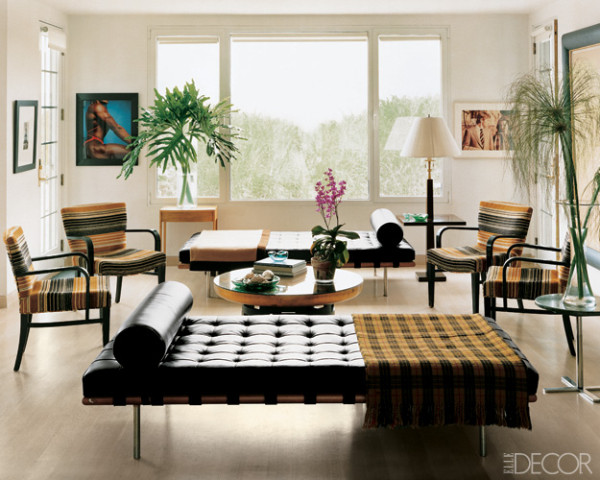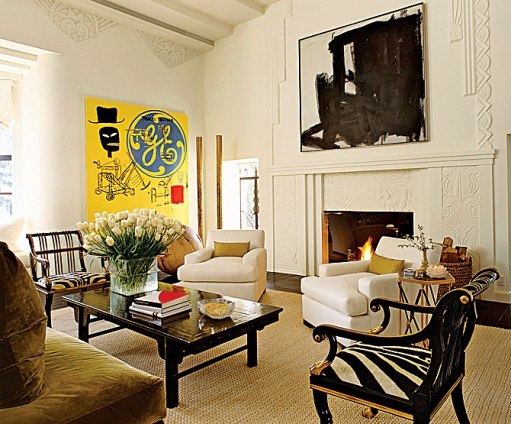Art is powerful, cathartic, transcendental, revolutionary, divisive, galvanizing, unusual, and novel. Art has a million attributes and adjectives that make it awesome (I am aware of the excessive use of A’s in that sentence). Because the visceral reactions effused and emanated from artwork can be so striking, some people also believe that art can be dangerous. It happened recently when Catholic University in Washington banned the emotionally charged play “Angels in America” , The School Board of the Fremont Unified School District voted to not include “Angels in America” on its AP English Reading List because of its use of primarily gay characters, and the original playhouse that showed the then burgeoning show (Charlotte Repertory Theatre) has since been shutdown. This occurred due to blatant anti-homosexuality reactions and protests over public funding and whose company and government dollars are funding WHAT art.

The master bedroom of artist Julian Schnabel’s duplex, with Picasso’s Femme au Chapeau. During World War II, Picasso who resided in Paris then was banned from exhibiting his art as his art forms did not confirm to the Nazi views on art. Photographs by Robert Polodori. Image found in Vanity Fair, HERE.

“Plates from a book of Picasso works and a drawing by Eric Fischl hang above a pair of custommade sofas in the living room; the vintage parchment-covered chairs are upholstered in a Rubelli fabric, the bamboo side tables are family heirlooms, and the rug is by de Gunzburg.” Photographer: William Waldron. Image found via Elle Decor, HERE.
This sort of reaction happened with shock artist Andre Serrano’s controversial work “Piss Christ” (which was still being vandalized as of 2011), The Holy Virgin Mary by Chris Ofili (and the ENTIRE “Sensation” show at The Brooklyn Museum in 2000), as well as Robert Mapplethrope’s 1989 National Endowment of the Arts’ funded retrospective The Perfect Moment. Who defines what is obscene, what is normal, and what is acceptable – the artist? the government? the patron?

Renee Cox , Missy at Home, 2008,76 x 101 cm. Jamaican-American artist Renée Cox’s depiction of Da Vinci’s famous, ‘The Last Supper’, entitled “Yo Mama’s Last Supper” (not shown above) included all the apostles as black men (sans one) and Renée herself serving as the centrepiece, posing naked in emulation of Christ. The image was considered banned in New York City by Rudy Guiliani until 2002, when Michael Bloomberg repealed a committee on morality. Image via Galerie Zidoun, HERE.
The National Endowment for the Arts was established in 1965. President Lyndon Johnson said upon signing the enabling legislation for the NEA, “We fully recognize that no government can call artistic excellence into existence…Nor should any government seek to restrict the freedom of the artist to pursue his own goals in his own way.” And yet…..20 grants have been controversial since the NEA’s inception (albeit out of TENS OF THOUSANDS)- and enough public funding has been openly questioned to shut down exhibitions, block a bevy of curse words, and challenge what it means to create something original.

Image from Elle Decor June 2006 of Jane Holzer’s home in Southampton, with vintage Hermès blankets, and photographs by artists Andres Serrano and Richard Prince, Photographer: Douglas Friedman. Found, HERE.

This dining room features tables by Maxime Old and mid-century orchestra chairs, as well as paintings by Chris Ofili (once banned and censored). The chandelier in the hallway was made from a basketball net by artist David Hammons.

The living room, by Joseph Matzo, Paul Vincent Wiseman and James Hunter, of The Wiseman Group, collaborated with architects Legoretta + Legoretta on a Maui house,October 2005. . The diptych is by Frank Stella. In a crazy series of events, Stella’s often quoted 1960’s phrase “What you see is what you see”, banned personal subjectivity and symbolism, this belief was the start of the abstraction known as minimalism – an intense reaction to post–World War II Western Art. Many of the shapes stella uses in his Polish Village series were from once banned Holocaust-era books; however Stella begs the user not to misconstrue his meaning or infer symbolism from a title. To my knowledge, Stella himself was never banned – although controversy has ensured over public funding of his ‘ugly’ works in South Korea HERE.
At one point or another Shel Silverstein, Walt Whitman, Richard Serra, Allen Ginsberg, Sandra Cisneros, Gwendolyn Brooks, Ani Difranco, Wassily Kandinsky, Piet Mondrian, Paul Klee, Marc Chagall, Lewis Carrol, George Orwell, John Milton, Voltaire, Dr. Seuss, and D.H. Lawrence have all been banned (to name a small few). Even before the days of the fantasy distopic novel Fahrenheit 451, wherein police officers burned books, Nazis were burning “so-called degenerate” artwork in huge pyres. According to Mallory Hellman in Let’s Go Paris, “A large amount of ‘degenerate art’ by Picasso, Dalí, Ernst, Klee, Léger and Miró was destroyed in a bonfire on the night of July 27, 1942 in the gardens of the Galerie nationale du Jeu de Paume in Paris.” Art work is a human’s self expression of individuality and autonomy. Any denial of ideas, creativity, and freedoms should be questioned. For a list of the more current visual art bans, try HERE or HERE or HERE.

Jane and Marc Nathanson hired designer Richard Hallberg to add a gallery for their art collection at their 1920s Art Déco Los Angeles residence, April 2007. The above living room’s fireplace is a 1960 Franz Kline oil. Andy Warhol (whose movies were banned in Boston and Chicago in 1960’s) and Jean-Michel Basquiat’s 1984-85 GE Tobacco Section is at left. Image found Here.
So as a big F*** You (censored myself, hahaha) to the past nonbelievers and haters of originality or genius – I present you with that idea of decorating with once banned artists. Free people, and create freely. Knowledge is power and ideas CAN be dangerous, but they CAN also be transformative. What is your stance?









